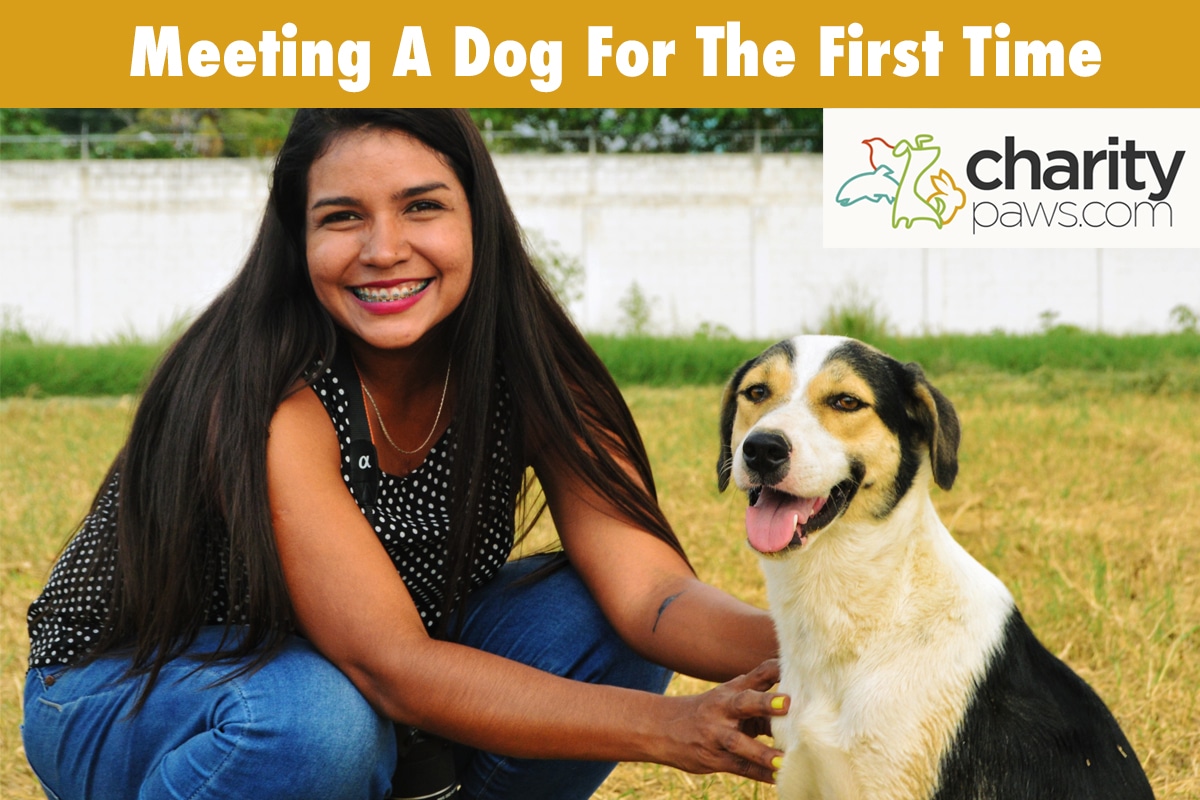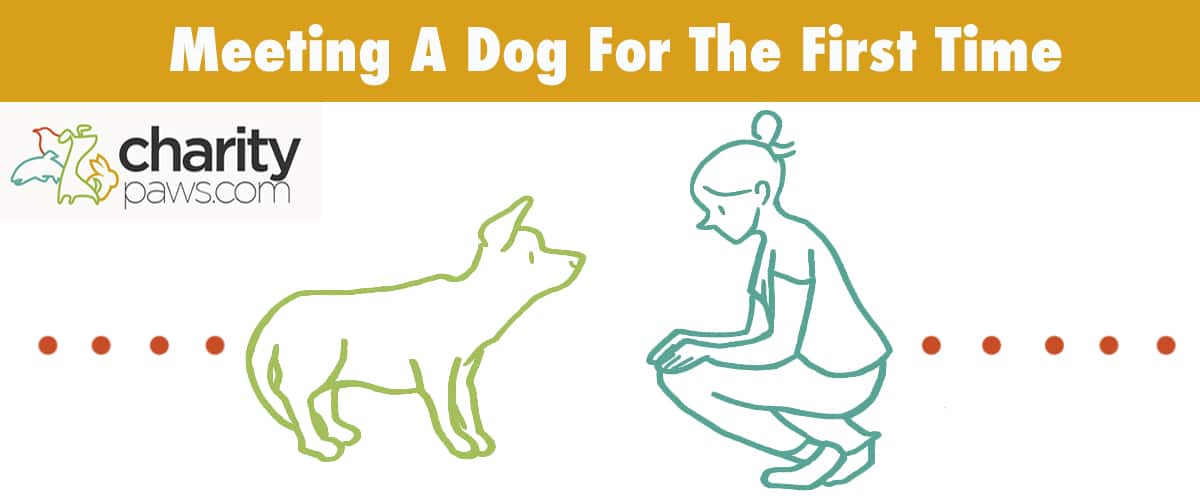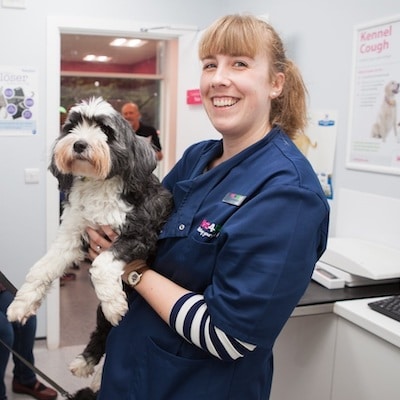Most of us know on a subconscious level the best way to greet a dog, but it’s easy to forget ourselves and get over-excited in the face of a new potential furry friend.
While many dogs are friendly and robust, some are not and an inappropriate greeting could lead to disastrous consequences.
So, let’s have a look at what to do when you meet a dog for the first time.
Why Is It Important To Greet A Dog Correctly?

Sadly, many people are bitten by dogs each year, and some of these incidents may have been prevented if dogs were greeted appropriately.
Beware Of Dog Bites
In 1994 The Center for Disease Control (CDC) reported an estimated 4.7 million dog bites in the United States, with injury rates being highest in 5 to 9-year-olds.
While accidents can always happen despite everyone’s best efforts, learning how to properly greet a new dog for the first time will help to reduce this risk.
Also, it’s worth bearing in mind that children that have not been taught how to approach a dog properly are more likely to have a negative experience.
This could lead to a lifelong fear of dogs.
As well as risking a bite injury, approaching a dog in the wrong way could lead to the dog feeling rushed, making it less likely to trust you.
It’s worth putting the extra time in to make a good first impression with any new canine.
How To Meet A New Dog: Step By Step
It’s a good idea to remind ourselves now and then as to the best way to greet a dog for the first time.
This is particularly true for novice dog owners or if you are perhaps trying to teach children the safest approach.
We have broken it down into the following simple step by step guide for you:
Think About The Dog’s Body Language
If the dog is showing clear signs of aggression, such as growling, teeth-baring, and snapping, then perhaps you should not approach them (unless absolutely necessary).
If a dog is already wound up and appears aggressive, then any attempts to get close to them could lead to a bite.
You may be best leaving this dog to settle down for a bit, before trying again later.
A nervous dog, doing things like trembling and cowering, may bite if he feels cornered and threatened.
Take extra time and care when greeting him.
A bouncy, friendly dog should be relatively safe, but even with these dogs, you should follow the recommended steps to ensure a positive first encounter.
Some dogs may appear fine on the surface, but change their demeanor if approached by strangers.
Above all, always ask the dog’s owner (if it has one) whether you can pet them as some dogs just don’t like the attention of strangers.
Think About Your Body Language
You should remain calm and confident when approaching a new dog.
If you are too excitable, with rapid movements or lots of noise then this could alarm the dog.
If you remain in control the dog will know you are not a threat.
Sadly, this is where children can often struggle.
Excitement and unpredictable movements could wind a dog up making them bouncy, or it could make them feel anxious and defensive.
Get Down To The Dog’s Level
Kneel or squat down so that you are nearer to the dog’s height.
Looming over them can make some dogs feel wary and threatened.
Bending over the top of a dog may be seen as a display of dominance so getting down to their level will make them feel more confident.
Leave a bit of space between you and the dog while you do this, and try a slight side-on approach rather than being face to face.
You should not hold direct eye contact with a dog as this could make them feel threatened.
Let The Dog Come To You
You should then allow the dog to come towards you in their own time.
If they are friendly, then this probably won’t take too long.
If they are a bit shyer then this could take a little while.
If the dog is looking scared or aggressive then you should back off at this point.
The dog is clearly not feeling comfortable and you should give them some more space.
Let The Dog Sniff You
Sniffing is a dog’s way of learning about you.
Most dogs will sniff and even lick each other when they meet for the first time, so it’s only natural they want to do the same when meeting you.
A dog can learn a lot about you through their incredibly sensitive noses.
If it appears safe to do so, hold your hand out steadily and slowly and let them take a sniff.
Keep your fingers tucked underneath and offer the top of your hand for sniffing, like a loose fist.
Talk Calmly To The Dog
If things are going well, now is the time to start talking to the dog.
Stick to calming neutral or even low tones when you speak.
Many people are guilty of being too over-enthusiastic when they talk, squeaking, and putting on baby voices.
This can make some dogs feel nervous, as the changes in pitch and tone can feel unpredictable.
Pet Them Under Their Chin
If the dog is reacting positively to you, then try petting them.
The safest way to do this is under the chin.
This feels less threatening to the dog than reaching over them to pet the top of their head or their back.
If the dog is enjoying the attention, then you can gradually move your hand around his face and ears.
Meeting A Rescue Dog For The First Time
Rescue dogs may have experienced trauma, neglect, or could have behavioral issues so could need extra time and care.
This isn’t true of all rescue dogs of course, some may just have come from families whose personal circumstances have changed, but it will still pay off to follow our above step-by-step guide carefully.
In addition to that, the following tips can help when meeting and deciding whether to adopt a rescue dog:
- Follow the lead of the foster care/rescue center staff. They may recommend treats or a favorite toy to help engage with the dog.
- Stay calm and controlled, even though you might be excited about meeting your potential new family member.
- Spend time interacting with the dog, even try walking the dog on a leash to see how it responds to your commands.
- Ask the foster care’s lots of questions like does the dog have any behavioral or health issues? What commands does it know? What are its activity levels like? What does the dog enjoy doing (ball games, being groomed, etc)?
- Understand that this dog is usually having a meet and greet session with other families too, so don’t be disheartened if he clicks with someone else better than you. You will eventually find the perfect pet for your family!
What Not To Do When Meeting A New Dog
Finally, if you want your first meeting with a new dog to go as well as possible, there are some things that you should avoid doing:
- Don’t force the interaction to go too quickly, give the dog time and space to get comfortable with you.
- Don’t stare directly into the dog’s eyes. This can be perceived as an act of dominance and can feel like a threat.
- Don’t bare your teeth at the dog. Big toothy grins may accidentally be seen as a threat, think about dogs snarling and baring their teeth before they fight, so try and maintain a neutral and calm expression.
- Don’t wear too much perfume. Being heavily perfumed with fragrance or aftershave can mask your own scent confusing dogs when they meet you. Dogs’ sensitive noses can become overwhelmed by fake scents.
- Don’t make any rapid movements or sudden sounds. Try and explain to young children that they must stay as calm as possible when approaching a dog, as being too excited or over-enthusiastic could be misinterpreted.
So You Have Met For The First Time, Did It Go Well Or Not?

Some first-time interactions with dogs go very smoothly indeed, and all of the above steps and tips are raced through with relative ease.
Friendly, properly socialized dogs will have no problem meeting new people and will be very easy to win over.
However nervous or aggressive dogs may take much longer to form a bond with.
If it is just a chance meeting with a dog on the street, then you will just move on from the experience, but if this is a dog you are potentially adopting or belongs to a friend or relative then you may need to persevere.
Some of the steps in our guide could take some time to work through with these dogs.
Just make sure you don’t push a dog too quickly and always read his body language.
It is worth being familiar with the “Ladder of aggression” as most dogs will show some very subtle cues to begin with when they are feeling anxious, such as licking their nose excessively and turning their head away.
If these signs are not detected then the dog will escalate things up the ladder eventually reaching more obvious signs of aggression such as growling and biting.
This can all be avoided if you back down and give the dog some space earlier on.
Just because a first meeting didn’t go as you hoped, it does not mean that the dog won’t eventually learn to trust you with a few more encounters.
Just follow the step-by-step guide each time and you might find that he starts to trust you enough to take treats, play ball with or walk on a leash.
Final Thoughts On Meeting A Dog For The First Time
When meeting any new dog for the first time your approach should be the same, calm and in control, allowing the dog time to come to you.
Try and teach young children to act in the same way around dogs, to try and reduce the chances of accidentally getting bitten.
Above all, make sure you ask permission from the owner of the foster care/rescue before trying to pet their dog, as some animals just don’t like strangers and it could take time to win them over.

